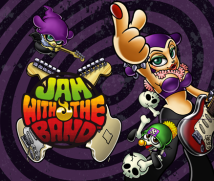2. Downloading Your Favourite Songs
Several new features have been added to this version of Jam with the Band, such as Voice Analysis and the ability to download songs. You just said that you were really happy to be making this game, Kitamura-san, but aren’t there normally many difficulties involved with the development process?
I really enjoyed the development process, to the extent that I wouldn’t even call it work.
My main job was to create the song data, which is very hard work. As soon as I’d made the data, however, all the staff snapped up the new songs, and started playing them immediately. I really felt all my hard work was being rewarded when I witnessed those scenes.
Whenever a new song was created, we’d say: “Let’s all play-test this one together!”, and we’d have a Jam Session. “Play-testing” was just the official name for it, though… (laughs)
It really cheered us up whenever a member of staff liked one of the new songs.
I don’t know if that’s work or play you’re talking about there! (laughs) But it’s a sign of how totally immersed you were in the software when you were making it. By the way, the new Jam with the Band has a feature that allows you to download up to 100* song scores. There were various challenges associated with the development of the song download feature, though, weren’t there? *Note: In the European version of Jam with the Band, the user has 50 pre-installed songs (the Japanese version had 31 pre-installed songs at launch) and can download another 50 songs via Nintendo Wi-Fi Connection. There is also space for an additional 100 songs created by users and saved or traded via Nintendo DS Wireless Communications. Also please note, unfortunately the Nintendo Wi-Fi Connection service is currently not available in South Africa.
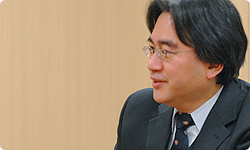
Yes, there were. No one can put songs that were protected by copyright onto Internet servers without first going through the necessary procedures. Since we’d already worked so hard to develop the Studio feature, though, we wanted to establish a sharing system that would allow it to support copyrighted songs as well. We thought that unless we developed a system whereby users didn’t have to pay for each song individually, not many people would use this feature.
How did you solve the copyright issues?
We made several visits to JASRAC5, and explained to them what we at Nintendo wanted to do. That is, to make as many Japanese pop and anime theme songs as possible available for download to the users. They responded to this request very positively, and as a result we were able to explain to them the system in which these songs would be loaded onto the Nintendo server in advance, ready for people to download and play on their Nintendo DS*. 5JASRAC (Japanese Society for Rights of Authors, Composers and Publishers) is a body that is entrusted with lyricists’, songwriters’ and musical publishers’ copyrights. It oversees the licensing of music to users, collecting royalties and distributing them to artists. *Note: In the European version of Jam with the Band, Nintendo has a copyright agreement with EMI Music Publishing Europe Ltd. rather than JASRAC and the popular song scores available for download are therefore versions of EMI-copyrighted songs. There are also copyright-free versions of classical scores as well as Nintendo theme tunes available.
It’s different to downloading a song you like onto your computer or mobile phone then, isn’t it?
Because the songs you download aren’t actually sung or performed, but instead are used as sound sources in the game, we only have to pay royalties to the songwriters and lyricists. It was therefore decided that Nintendo would pay the royalties incurred by up to 100 songs, based on the actual download data. As such, we were able to implement a system where a user can freely and effortlessly download up to 100 of their favourite songs.
A song that’s been downloaded cannot be deleted, can it?
If a user were able to delete songs, then they’d be able to download as many as they like.
If we implemented an unlimited download system, the royalty payments we’d have to make would become a big problem.
But don’t users ever think: “I didn’t actually want this song” after downloading it?
It should be alright, because we’ve implemented a ‘trial listen’ system. We’ve made it so that a user can only download songs they’ve heard for themselves and decided that they like. There is also a ‘Rate’ feature, so that users can check a song’s rating by the other players before downloading it.
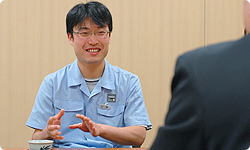
There will initially be around 200 songs available for download this time. With the user able to download up to 100* songs, I’m sure there’ll be some who think: “Huh!? Only 200!?” *Note: In the European version of Jam with the Band, the user can download another 50 songs via Nintendo Wi-Fi Connection. Unfortunately the Nintendo Wi-Fi Connection service is currently not available in South Africa.
That is something we’d like to ask ‘Band Brothers artists‘ all over the country to help us out with. These are the people who uploaded songs they’d made using the previous version of the software onto their blogs and other sites. This time, songs can be submitted onto the Nintendo server, so we hope it will become an outlet for songs.
So this means that even songs that become big hits after Jam with the Band has been released can be enjoyed using the software.
Every song that is managed by JASRAC6 can be uploaded onto the server*, so users should be able to find songs that they like. 6Songs that are copyright-managed by JASRAC (domestic songs for which they’ve been entrusted the copyright in the ‘Interactive Transmission’ category) and domestic or foreign songs that are in the public domain can be posted on the server. To check a song’s copyright status, please check J-WID (the JASRAC product database search tool). *Note: In Europe, users can search a complete list of the songs available for upload purposes at the official European Nintendo Jam with the Band website. Unfortunately the Nintendo Wi-Fi Connection service, which allows for this feature, is currently not available in South Africa.
If a large number of songs are submitted onto the server, won’t that mean that some of them will be of rather questionable quality?
Barbara will be judging the songs, so it’ll be fine. (laughs)
Mentioning Barbara like that shows how determined you are to talk about the game! (laughs) Actually, whenever a JASRAC song is submitted onto the server, it is necessary to enter a JASRAC registration number*. We’ve installed a feature so that if this number is entered incorrectly, or if the song doesn’t have the right number of instruments or is too short, the song is automatically rejected. As such, it is possible that a song a user has put a lot of time and effort into could be rejected like this, so we’d like all the users to read the ‘Submit’ section of the Instruction Booklet before submitting a song. * The European equivalent of a JASRAC registration number is a "Song Code". The Song Code for each submission can be found at the official European Nintendo website for Jam with the Band in the "Nintendo Music Database". Please note, unfortunately this feature is not available for South Africa.
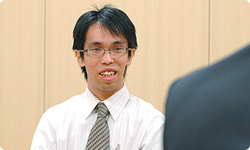
Also, only songs that have been compared to the original by an expert will be allowed onto the download server, and only after they’ve passed this check.
So only songs that have reached a certain standard can be downloaded and enjoyed.
There are also two ways of submitting songs. Users who are able to use Nintendo WFC can submit their songs from home. Alternatively, songs can be easily submitted using ‘DS Stations’ in shops*. *Note: The DS Station upload service is not available in Europe or South Africa.
Downloading can also be done at home or in shops. Users are also able to see how many times each song has been downloaded.
So we’re able to satisfy all the ‘Band Brothers artists‘ who are thinking “I want the songs I make to be enjoyed by lots of people”, without infringing on the rights of the songs’ copyright holders. In the sense that it doesn’t place a burden on the users either, it really is a unique and very interesting system.
In this version of Jam with the Band, we’ve added a new ‘Sing’ mode. We first got this idea when wondering if there weren’t any other uses, apart from the playing the instruments, for the sheet music in Jam with the Band. I think that everyone’s sung in the past, even people who’ve never played a musical instrument.
There’s a Voice Analysis feature as well, isn’t there?
The first thing we did was conduct a series of experiments, using a program to check singing voices, to see what components of the voice could be used for analysis. We were able to check a voice’s pitch and rhythm as a result, and as we were thinking how to make the best use of these analytical tools, our thoughts turned to karaoke.
When we thought about people’s goals at karaoke, we came to the conclusion that people want to get excited, to sing well and to seem attractive... I think that, especially if it’s a social event or a kind of date, you want to sing your best song and you want everyone to think that you’re a great singer. That’s why we hope that people will use the Voice Analysis feature to find a song they’re compatible with before going to karaoke and trying out the real thing in front of that important person. (laughs)
We even called it ‘hotness rating’ instead of ‘compatibility’ during development. I suppose you could say our motives were not entirely innocent…
(laughter)
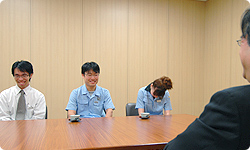
You shut yourself up in a sound booth and took turns to sing, didn’t you?
Once I went into the booth and didn’t come back to my seat for 30 minutes.
I think that work was officially called ‘sampling’, but it was sampling work in name alone.
This sound booth sounds more like a karaoke box to me! This project seems to have involved a lot of work that was work ‘in name alone’. By the way, what did the Voice Analysis feature tell you about your singing style?
My style was ‘Moody Ballad’, because my voice is quite low.
Mine was R&B.
(she looks a little embarrassed) Mine was…Bubblegum Pop.
(laughter)
Just out of curiosity, Bubblegum Pop doesn’t always mean you’re a good singer, does it?
I’m like one of those manufactured pop stars in the sense that I’m always out of tune.
(laughter)
